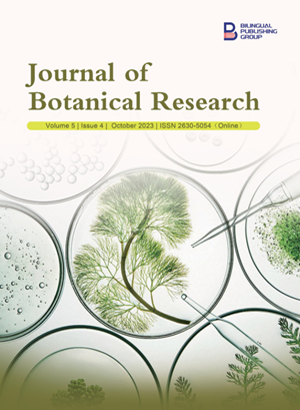-
245
-
200
-
169
-
168
-
137
Diversity and Abundance of Amenity Trees in the Premises of International Institute of Tropical Agriculture (IITA), Ibadan, Nigeria
DOI:
https://doi.org/10.30564/jbr.v5i4.5753Abstract
Amenity trees are an essential element of most urban communities, contributing significantly to human well-being and improving environmental quality. Good knowledge of the diversity and abundance of trees in our environment and their importance can help promote conservation, which is essential for sustainability. This study aimed at assessing the diversity and abundance of amenity trees on the premises of the International Institute of Tropical Agriculture (IITA), Ibadan Nigeria. The institute was divided into working and residential areas. The trees in the study area were identified using a walking and windshield survey. A total population of 2626 trees from 126 species and 42 families were identified on the premises of IITA. The highest tree population of 523 trees was recorded in the Tropical Crescent residential area with 321 trees of Lagerstroemia speciosa being the most frequent species. Across working and residential areas, Elaeis guineensis was the most frequent species accounting for 19.92% of the total tree population. A Shannon-Wiener Diversity Index (H’) of 3.383 and species evenness of 0.43 was obtained from the study area. The high values of diversity indices obtained indicate that IITA premises are rich in diverse tree species both indigenous and exotic hence should be referenced as a good urban landscape. The current management practices can be recommended for other institutions.
Keywords:
Amenity trees; Species diversity; Abundance; IITA; IbadanReferences
[1] Cullen, S., 2007. Putting a value on trees—CTLA guidance and methods. Arboricultural Journal. 30(1), 21-43. DOI: https://doi.org/10.1080/03071375.2007.9747475
[2] Akbari, H., 2002. Shade trees reduce building energy use and CO2 emissions from power plants. Environmental Pollution. 116, S119-S126.
[3] Tyrväinen, L., Pauleit, S., Seeland, K., et al., 2005. Benefits and uses of urban forests and trees. Urban forests and trees. Springer: Berlin, Heidelberg. DOI: https://doi.org/10.1007/3-540-27684-X_5
[4] Rogers, K., Hansford, D., Sunderland, T., et al. (editors), 2012. Measuring the ecosystem services of Torbay’s trees: The Torbay i-Tree Eco pilot project. Trees, People and the Built Environment Proceedings of the Urban Trees Research Conference; 2011 Apr 13-14; Edinburgh. p. 18-28.
[5] Olajuyigbe, S.O., Akwarandu, K.E., 2019. Floristic composition and stand structure in a tropical watershed forest: Implication for biodiversity conservation. Environtropica. 15, 79-94.
[6] Egunjobi, L., 1989. Perception of urban environmental problems: A pilot study of the city of Ibadan, Nigeria. African Urban Quarterly. 4(1-2), 59-67.
[7] Babalola, F.D., Raji, I.A., 2016. Perception of urban trees at main campus of University of Ilorin, Ilorin, Kwara State, Nigeria. Applied Tropical Agriculture. 21(1), 60-67.
[8] Martens, D., Gutscher, H., Bauer, N., 2011. Walking in “wild” and “tended” urban forests: The impact on psychological well-being. Journal of Environmental Psychology. 31(1), 36-44.
[9] Suratman, M.N., 2012. Tree species diversity and forest stand structure of Pahang National Park, Malaysia. Biodiversity enrichment in a diverse world. IntechOpen: London. pp. 473-492.
[10] Ashman, T.L., Knight, T.M., Steets, J.A., et al., 2004. Pollen limitation of plant reproduction: Ecological and evolutionary causes and consequences. Ecology. 85(9), 2408-2421.
[11] Mani, S., Parthasarathy, N., 2006. Tree diversity and stand structure in inland and coastal tropical dry evergreen forests of peninsular India. Current Science. 90, 1238-1246.
[12] Omoro, L.M., Pellikka, P.K., Rogers, P.C., 2010. Tree species diversity, richness, and similarity between exotic and indigenous forests in the cloud forests of Eastern Arc Mountains, Taita Hills, Kenya. Journal of Forestry Research. 21, 255-264.
[13] Ariyo, O., Oluwalana, S., Ariyo, M., 2018. Profitability analysis of non-timber forest products collected from block a and golf course forests of international institute of tropical agriculture (IITA), Ibadan, Oyo State, Nigeria. Advances in Research. 14(2), 1-12. DOI: https://doi.org/10.9734/AIR/2018/3958
[14] Tenkouano, A., Baiyeri, K.P., 2007. Adaptation pattern and yield stability of banana and plantain genotypes grown in contrasting agroecologies in Nigeria. African Crop Science Conference Proceedings. 8, 377-384.
[15] Oduwaiye, E.A., Ajibode, M.O., 2005. Composition of tree species and regeneration potential at Onigambari forest reserve, Ibadan, Oyo State, Nigeria. Journal of Raw Materials Research. 2(1), 4-13.
[16] Price, P.W., 1997. Insect ecology, 3rd Edition. John Wiley & Sons, Inc.: New York.
[17] Kent, M., Coker, P., 1992. Vegetation description and analysis: A practical approach. John Wiley and Sons: New York.
[18] Agbelade, A.D., Onyekwelu, J.C., Apogbona, O., 2016. Assessment of urban forest tree species population and diversity in Ibadan, Nigeria. Environment and Ecology Research. 4(4), 185-192.
[19] Haastrup, N.O., Dahunsi, O.M., Baba, G.O., 2019. Diversity and abundance of tree species at Owo Forest Reserve, Ondo State, South-Western Nigeria. International Journal of Research and Innovation in Applied Science. 4(7), 27-32.
[20] Ogundele, O.M., Ige, P.O., Owoeye, Y.T., et al., 2021. Tree species diversity and abundance of Akure Forest Reserve, Ondo State, Nigeria. Journal of Applied Sciences and Environmental Management. 25(8), 1415-1419.
Downloads
How to Cite
Issue
Article Type
License
Copyright © 2023 Author(s)

This is an open access article under the Creative Commons Attribution-NonCommercial 4.0 International (CC BY-NC 4.0) License.




 Yewande Owoeye
Yewande Owoeye






